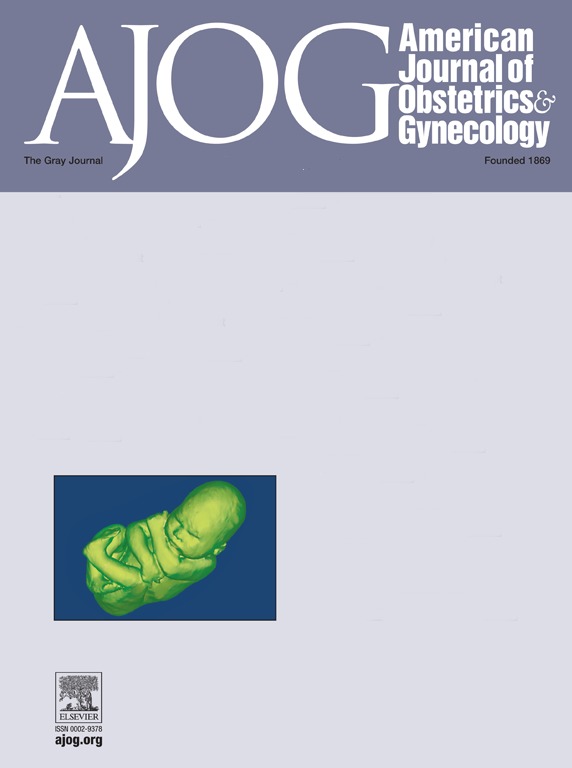Impact of exercise training during pregnancy on maternal biomarkers: A systematic review.
IF 8.4
1区 医学
Q1 OBSTETRICS & GYNECOLOGY
引用次数: 0
Abstract
OBJECTIVE The aim of this systematic review was to identify and analyze biomarkers that are influenced by physical exercise during pregnancy and that contribute to maternal-fetal health and development. DATA SOURCES A comprehensive systematic search of PubMed, Web of Science, and EBSCO Host databases was conducted without time restriction in accordance with PRISMA guidelines (PROSPERO ID: CRD420251017740). STUDY ELIGIBILITY CRITERIA Eligible studies were randomized controlled trials examining the effects of exercise interventions during pregnancy on biomarkers measured in maternal serum, umbilical cord blood, breast milk, and placental tissue. STUDY APPRAISAL AND SYNTHESIS METHODS Eleven randomized controlled trials meeting inclusion criteria were analyzed. The effects of different exercise modalities, durations, and intensities on a wide range of biomarkers were evaluated. RESULTS Exercise interventions performed for 12 weeks or longer with 2-3 weekly sessions at moderate-to-vigorous intensity, demonstrated significant effects on several biomarkers. These included a reduction in pro-inflammatory markers (TNF-α, IL-6), an increase in anti-inflammatory cytokines (IL-10), improved lipid profiles (lower LDL, triglycerides), improved glucose regulation, and favorable changes in hormonal markers such as leptin and BDNF. Additionally, exercise was associated with positive changes in umbilical cord blood cytokines, immunologic composition of breast milk, and placental mineral content. CONCLUSIONS Structured exercise programs during pregnancy, particularly resistance training and aerobic exercise performed in the same session, show promising effects on modulating inflammatory, metabolic, and immunologic biomarkers that may contribute to improved maternal-fetal health outcomes. However, current evidence is limited by methodological heterogeneity and lack of data from early pregnancy.孕期运动训练对母体生物标志物的影响:一项系统综述。
目的:本系统综述的目的是识别和分析受孕期体育锻炼影响并有助于母胎健康和发育的生物标志物。数据来源根据PRISMA指南(PROSPERO ID: CRD420251017740),对PubMed、Web of Science和EBSCO Host数据库进行了全面的系统检索,没有时间限制。入选标准:入选的研究为随机对照试验,研究孕期运动干预对母体血清、脐带血、母乳和胎盘组织中生物标志物的影响。研究评价与综合方法对符合纳入标准的随机对照试验进行分析。评估了不同运动方式、持续时间和强度对各种生物标志物的影响。结果:进行为期12周或更长时间的运动干预,每周2-3次,中等至高强度,对几种生物标志物有显著影响。其中包括促炎标志物(TNF-α, IL-6)的减少,抗炎细胞因子(IL-10)的增加,脂质谱的改善(低密度脂蛋白,甘油三酯的降低),葡萄糖调节的改善,以及瘦素和BDNF等激素标志物的有利变化。此外,运动与脐带血细胞因子、母乳免疫成分和胎盘矿物质含量的积极变化有关。结论孕期有组织的锻炼计划,特别是在同一阶段进行阻力训练和有氧运动,在调节炎症、代谢和免疫生物标志物方面显示出有希望的效果,这可能有助于改善母胎健康结局。然而,目前的证据受到方法异质性和缺乏早期妊娠数据的限制。
本文章由计算机程序翻译,如有差异,请以英文原文为准。
求助全文
约1分钟内获得全文
求助全文
来源期刊
CiteScore
15.90
自引率
7.10%
发文量
2237
审稿时长
47 days
期刊介绍:
The American Journal of Obstetrics and Gynecology, known as "The Gray Journal," covers the entire spectrum of Obstetrics and Gynecology. It aims to publish original research (clinical and translational), reviews, opinions, video clips, podcasts, and interviews that contribute to understanding health and disease and have the potential to impact the practice of women's healthcare.
Focus Areas:
Diagnosis, Treatment, Prediction, and Prevention: The journal focuses on research related to the diagnosis, treatment, prediction, and prevention of obstetrical and gynecological disorders.
Biology of Reproduction: AJOG publishes work on the biology of reproduction, including studies on reproductive physiology and mechanisms of obstetrical and gynecological diseases.
Content Types:
Original Research: Clinical and translational research articles.
Reviews: Comprehensive reviews providing insights into various aspects of obstetrics and gynecology.
Opinions: Perspectives and opinions on important topics in the field.
Multimedia Content: Video clips, podcasts, and interviews.
Peer Review Process:
All submissions undergo a rigorous peer review process to ensure quality and relevance to the field of obstetrics and gynecology.

 求助内容:
求助内容: 应助结果提醒方式:
应助结果提醒方式:


